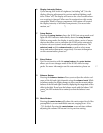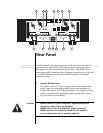
20
There are two recommended methods for connecting speaker
cables to your amplifier. A high-quality spade lug or hook lug, sol-
dered to the cable (or crimped with extremely high pressure), is
best.
Spade lug Hook lug
Connect a + (positive or red) output post of the amplifier to the +
(positive or red) input terminal of the appropriate loudspeaker. [If
biwiring, repeat using the other + (positive or red) output post of
the amplifier and the + (positive or red) input terminal of the
loudspeaker.]
Connect a – (negative or black) output post of the amplifier to the
– (negative or black) input terminal of the appropriate loud-
speaker.
Caution! DO NOT OVERTIGHTEN the binding posts on your
amplifier! The unique design of these posts gives far
more leverage than traditional posts. You will achieve
tight, high contact pressure connections with only
modest finger-tightening, and without having to resort
to special tools.
DO NOT FORCE the “wings” up and over a bent or
oversized connector, as this may damage the binding
post. If your connectors obstruct the turning of the
“wings,” slide them into place when the binding post
opening is a snug fit; then apply a final quarter-turn as
needed to tighten the connection.
2 External IR Input
The Nº383 incorporates an infrared repeater input to facilitate a
wide range of installation options. If desired, the Nº383 may be
placed inside a cabinet or outside the normal line-of-sight in the
listening area, with the controlling IR signal being relayed to the
Nº383 by any of a number of commercially-available IR repeaters.
The specifications for this ir input call for a triggering voltage of
5 volts at no more than 100 milliamps of current, with the tip of
the
1
⁄8" mini-plug having positive polarity, as below:


















